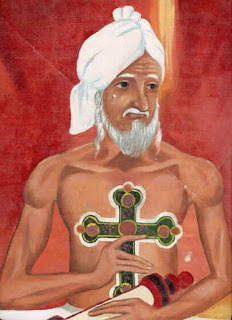Exploring the intersection of indigenous visual art and the Gospel of Jesus Christ.
Monday, May 28, 2012
Guatemalan Painter Manuel Reanda
Manuel Reanda is a self -taught Tzutujil painter who lives in Santiago Atitlan, Guatemala. Manuel was born in 1948 and, though he was orphaned at six years of age, he had already begun drawing on the walls of his home with pieces of charcoal each day before going to school.
Manuel committed himself to a lifelong pursuit after finishing elementary school. During this formative period of his life, he apprenticed for five years under the city's first "master" painter, Juan Sisay. As an adult he studied mural painting in Mexico City with Juan O’Gorman, a student of the famous Mexican muralist Diego Rivera. In the years since, he has passed on his knowledge of painting to many students of various ages.
Sunday, May 20, 2012
A Brief History of Visual Contextualization in India Part 4: Saint Thomas Christians
For this installment in my series "A Brief History of Visual Contextualization in India," I'll be discussing India's first Christian community, the Saint Thomas Christians (or "Nasrani"). Saint Thomas Christians traditionally live in the southwestern coastal state of Kerala and descend from a union of the local Indian population with a Jewish diaspora community, who had become Christians in the earliest days of the faith. The Saint Thomas denominations use a Syriac liturgy in their church services and trace their spiritual heritage back to the assumed arrival of the Apostle Thomas ("Doubting Thomas") in southern India in 52 A.D. In the third century, Nestorian Christian missionaries from the Church of the East in Persia began to settle in Kerala and organize the churches there according to their beliefs and liturgy. Later in 1665, due to religious pressure from Portugese Catholics, the Saint Thomas Christians began to split into various factions along Catholic/Nestorian lines. Today, this schism has resulted in several different Saint Thomas denominations, including Nestorian, Catholic, Orthodox, and even (since 1961) Evangelical!
Tuesday, May 15, 2012
Headstone with Lotus and Cross
While I'm slowwwwly writing the next post on my series A Brief History of Visual Contextualization in India, here's a cool image from the USF Ricci Institute for Chinese-Western Cultural History that I came across showing a beautiful Christian headstone from China. It dates from the Yuan dynasty (1272—1368) and is now located in the Quanzhou Maritime Museum. The caption reads:
Headstone showing a cross on a lotus flower and a cloud design set within a plain border following a curved outline. This basic design is repeated extensively in the Christian monuments dated to this period, although its iconographic import is unknown.
Wednesday, May 9, 2012
Mehindi Job Training in South Asia Uses Bible Stories
I recently came across the following blog entry by a Christian worker in South Asia, Lucy Chilton (not her real name). She describes her use of henna/mehindi designs inspired by the Bible while giving job training to local women at a beauty salon school and sewing center. If you are a lady who is interested in this art form, and wonder how it could be used to communicate the Gospel in South Asia or anywhere in North Africa or the Middle East, I suggest you read on. For the rest of you, please read on anyway and rejoice that God is using cultural art forms to draw his children to Himself!
You can also check out my earlier post on the use of some of these same henna/mehindi designs by another missionary here.
Here is Lucy's post:
Tuesday, May 1, 2012
Engelbert Mveng: A Theology of Life Expressed in Art
 |
| Eighth Station of the Cross |
Engelbert Mveng was born in 1930 near Yaoundé, Cameroon, to Presbyterian parents. He eventually became a Jesuit priest, as well as a historian, poet, artist, philosopher, and theologian. ArtWay.eu, a website that seeks to open up the world of the visual arts to interested Christians, writes that “Father Mveng studied the aesthetics of African arts and published his findings in numerous books and articles. ... His teaching was based on what he called the universal rules of African art. As a historian and theologian he made a great contribution to the study of African culture and history, especially in the realms of cultural and religious anthropology and iconology.”
Subscribe to:
Comments (Atom)



